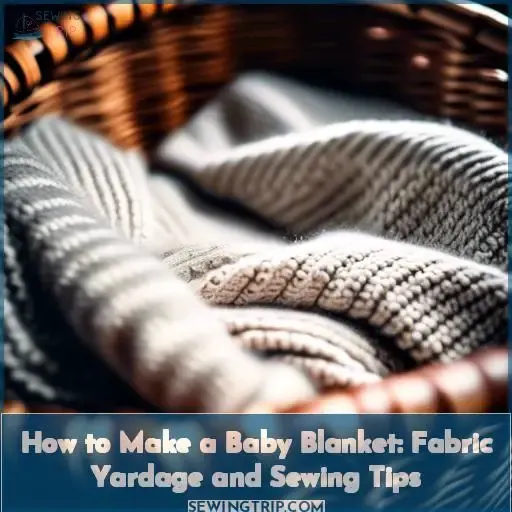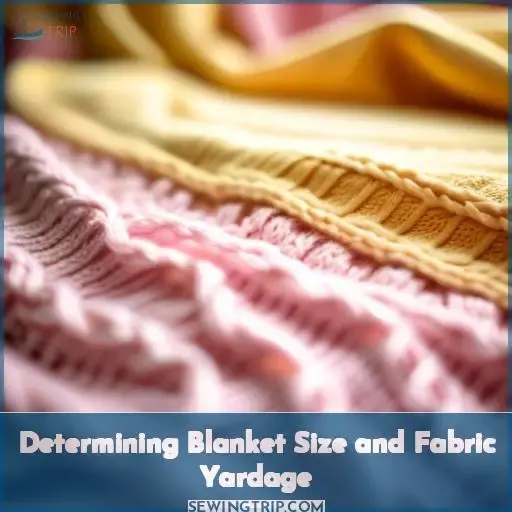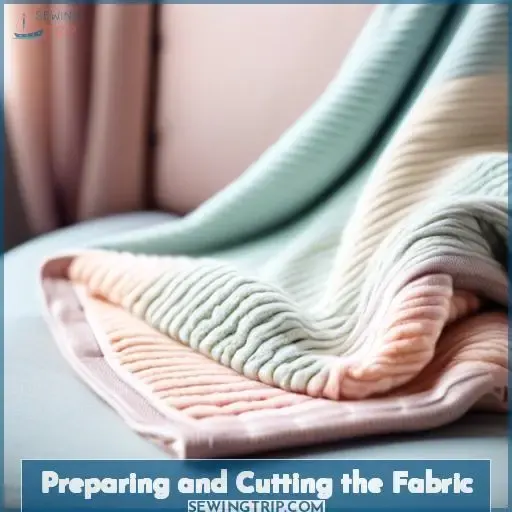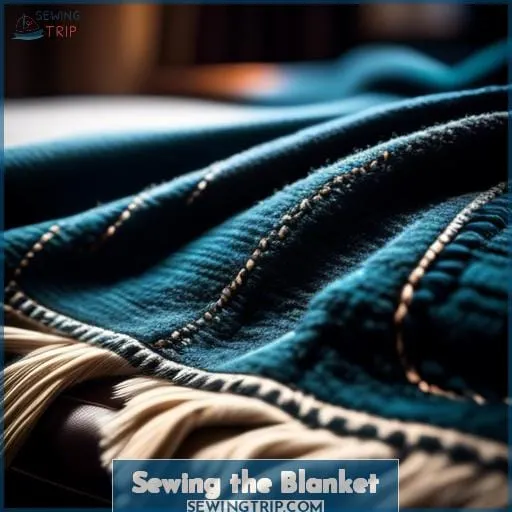This site is supported by our readers. We may earn a commission, at no cost to you, if you purchase through links.
 To make a baby blanket, you’ll typically need one to two yards of soft, warm fabric. For a small baby, blankets need only be a yard to a yard and a half long and two feet across.
To make a baby blanket, you’ll typically need one to two yards of soft, warm fabric. For a small baby, blankets need only be a yard to a yard and a half long and two feet across.
For an older child, use at least two square yards. If you want to make a fringed blanket, allow an extra three to six inches of fabric all the way around.
Good fabrics to use for blankets include flannel, quilting fabric, faux fur, and especially polar fleece. Be careful with baby blankets and do not put a baby to sleep in a crib with a blanket until they are at least 12 months old to reduce the risk of crib death.
Table Of Contents
- Key Takeaways
- How Many Yards of Fabric for a Baby Blanket
- Selecting the Right Fabric
- Determining Blanket Size and Fabric Yardage
- Preparing and Cutting the Fabric
- Sewing the Blanket
- Finishing Touches and Safety Considerations
- Blanket Types and Dimensions
- Calculating Yardage for Different Blanket Sizes
- Fabric Selection and Color Scheme
- Sewing Techniques and Safety Considerations
Key Takeaways
- Baby blankets typically require 1-1.5 yards of fabric and are 2 feet across.
- Older child blankets need at least 2 square yards of fabric.
- When making fringed blankets, add an extra 3-6 inches of fabric all around.
- It is crucial to choose soft, natural, and breathable fabrics for baby blankets to ensure comfort and safety.
How Many Yards of Fabric for a Baby Blanket
To make a baby blanket, you typically need around 2 yards of fabric. This amount is suitable for creating a cozy and comfortable blanket for a baby.
Selecting the Right Fabric
To make a baby blanket, you’ll need the following materials:
- 1 yard of fabric for the front and back (e.g., Let Them Be Little Panel Pink with Gold Sparkle and Let Them Be Little Fruit White)
- Coordinating quilting thread
- 1 yard of high loft batting
The instructions for making the blanket include:
- Trim fabric selvage edges and clean up.
- Cut batting to match panel size (44 x 36).
- Pin batting to fabric, then pin fabrics together (right sides together).
- Sew around fabric with 1/2 seam allowance, leaving a 4-5 inch opening for turning.
- Turn right side out and press edges.
- Press and pin opening closed.
- Topstitch around edge, 1/4 from edge, closing opening.
- Topstitch around panel boxes on front.
- Backstitch and trim threads.
The benefits of making a baby blanket include:
- Ideal baby shower gift
- Quick and easy project
- Adorable result
- Requires only two yards of fabric
Tips for making the blanket include:
- Use any two prints from a fabric line.
- Choose a coordinating thread.
- Insert a layer of batting between fabrics.
- Quilt top by following panel lines.
- Trace boxes for a unique look.
Variations for the blanket include:
- Tie layers together with yarn instead of sewing.
- Use red, pink, or white yarn for tying.
- Topstitch around any number of boxes.
For a baby blanket, you’ll need 1-2 yards of fabric, depending on the size of the blanket. You can choose from various fabric options, such as cotton, quilting fabric, faux fur, or polar fleece. Remember to follow safe sleep guidelines and wait until your baby is at least 12 months old before using a blanket for sleeping.
Soft and Safe Materials
When crafting a cozy nest for a little one, you’ll want to wrap them in the softest, safest materials. Choose fabrics that are gentle on delicate skin and stand up to countless snuggles and washes.
- Opt for organic fabrics like cotton minky or flannel for hypoallergenicity and fabric breathability.
- Select minky fabric or polar fleece for their plush softness and temperature regulation.
- Prioritize durability and baby blanket safety in your fabric choices.
Pre-washing Fabrics
Pre-washing your fabrics is a crucial step in preparing them for your baby blanket project. This process helps prevent shrinkage and ensures color fastness, ensuring your blanket will last longer and look great.
- Follow the fabric care instructions: Different fabrics require different washing methods. Always check the care label before washing.
- Wash separately: Wash your fabrics separately to avoid color transfer and fabric damage.
- Use cold water: Cold water is generally safer for fabrics and helps prevent shrinkage.
- Avoid bleach: Bleach can damage some fabrics and may affect color fastness.
- Dry on low heat: If you need to dry your fabrics, use a low heat setting to prevent shrinkage.
By following these steps, you’ll be well on your way to creating a beautiful, long-lasting baby blanket.
Determining Blanket Size and Fabric Yardage
To determine the amount of fabric needed for a baby blanket, you can refer to the following guidelines:
- For a baby blanket, you typically need at least 2 yards of fabric, as mentioned in the search result.
- For a stroller blanket, you need 1 yard of fabric.
- For a receiving blanket, you need 1.25 yards of fabric.
- For a crib blanket, you need 1.5 yards of fabric.
- For a toddler blanket, you need 1.5 yards of fabric.
These yardage requirements are based on a fabric width of at least 44 inches. If your fabric is narrower, you may need to adjust the yardage accordingly.
When selecting the fabric, consider using soft, natural, and breathable fibers like flannel, quilting fabric, faux fur, or polar fleece. If you’re using two different fabrics for a double-sided blanket, ensure they’re coordinating in color scheme and theme.
Remember to pre-wash all fabrics before sewing to prevent shrinkage and ensure they’re clean and safe for the baby.
Blanket Types and Dimensions
When it comes to making a baby blanket, there are several factors to consider, including the type of fabric, the dimensions of the blanket, and the amount of fabric needed.
-
Selecting the Right Fabric: Choose soft and safe materials for your baby blanket. Pre-wash all fabrics before sewing to prevent shrinkage and ensure the fabric is clean. Consider using flannel, quilting fabric, faux fur, or polar fleece for your blanket.
-
Determining Blanket Size and Fabric Yardage: The size of your blanket will depend on its intended use. For a stroller blanket or receiving blanket, you’ll need about 1 yard of fabric for the front and 1 yard for the back. For a crib blanket, you’ll need 1.5 yards of fabric for the front and back, and for a toddler blanket, you’ll need 1.5 yards of fabric that’s at least 60 inches wide. Keep in mind that you may also need fabric for binding, depending on the type of binding you choose.
-
Preparing and Cutting the Fabric: Trim off the selvage edges and clean up the edges of the fabric to ensure they’re the same size. Cut the fabric and batting to match the panel size.
-
Sewing the Blanket: Pin the batting to the fabric and then pin the fabrics together, right sides together. Sew around the fabric with a 1/2 seam allowance, leaving a 4-5 inch opening for turning. Turn the fabric right side out and press the edges. Pin the opening closed and topstitch around the edge, 1/4 inch from the edge, closing the opening.
-
Finishing Touches and Safety Considerations: After sewing the blanket, you can add decorative topstitching around the panel boxes on the front. Backstitch and trim threads to finish the blanket. Always follow guidelines for safe baby sleeping practices, such as avoiding heavy or loose blankets and keeping blankets away from baby’s face.
Calculating Yardage for Different Blanket Sizes
To determine the yardage needed for a baby blanket, consider the following factors:
- Blanket Size: Standard baby quilt sizes range from 30 x 30 for newborns to 36 x 52 for crib-sized blankets.
- Fabric Width: Quilting cotton is typically sold in widths of 40-42 inches.
- Fabric Yardage: For a 40 square baby quilt, you’d need approximately 2 yards of fabric.
- Additional Fabric: If you’re unsure about the accuracy of your yardage or need a bigger margin of error for cutting or longer quilting, consider adding an additional 1/8 – 1/4 yard to each fabric requirement.
- Safety Practices: Always double-check your measurements and calculations to ensure accurate results.
For a crib blanket, you’d need about 1.5 yards of fabric for the front and back, and 1 yard for the backing. For a toddler blanket, you’d need 2 square yards of fabric for the front and back, and 1 yard for the backing.
Remember to pre-wash your fabric before cutting and sewing to prevent shrinkage and color bleeding after the quilt is completed. Choose high-quality quilting cotton for durability and easy sewing. Consider fabric safety, especially for baby quilts, ensuring that the fabric is free from harmful chemicals and meets safety standards.
Coordinate colors and prints for a visually appealing and cohesive look. Explore organic and eco-friendly options for a more sustainable choice. Purchase extra fabric to account for mistakes or adjustments during the quilting process.
Preparing and Cutting the Fabric
Before you start sewing, it’s crucial to trim the selvage edges off your fabric. This ensures your fabric and batting are cut to the exact size needed for your project.
Trimming Selvage Edges
When preparing to make a baby blanket, one crucial step is trimming the selvage edges. Selvages are the tightly woven edges on the fabric that prevent it from unraveling. While some sewists leave them on, especially when using the entire piece of fabric, it’s generally recommended to remove them for most projects.
Here are four reasons to trim the selvage edges before starting your baby blanket project:
-
Straight Grain: Selvages can be slightly off-grain, which may cause issues when cutting pattern pieces or sewing seams. Trimming them ensures that your fabric’s straight grain is used, resulting in more accurate cuts and better alignment during sewing.
-
Even Fabric Width: Selvages can vary in width, which might lead to uneven fabric edges. Removing them ensures that your fabric has a consistent width throughout, making it easier to work with and providing a more professional-looking finished product.
-
Avoid Puckering: Selvages may shrink differently than the rest of the fabric during washing or pressing, causing puckering in your finished project. By trimming them off, you minimize the risk of this issue and create a smoother, flatter blanket.
-
Easier Sewing: Trimmed edges allow for easier sewing, especially when joining multiple pieces of fabric. The machine’s feed dogs can grip the fabric more evenly, resulting in smoother, more consistent stitches.
To trim the selvage edges, follow these steps:
- Lay your fabric out flat, ensuring it’s not twisted or stretched.
- Using a rotary cutter, ruler, and cutting mat, or sharp scissors, trim along the selvage edge, removing any frayed or uneven threads.
- Be careful not to cut into the actual fabric, focusing only on the selvage itself.
- Repeat this process for all selvage edges, ensuring your fabric is now free from these tightly woven edges.
By following these steps, you’ll have a better foundation for your baby blanket project, resulting in a more professional-looking and well-constructed finished product.
Cutting Fabric and Batting to Size
Once you’ve chosen your panel and pattern, it’s time to measure up! Lay your fabric flat, ensuring no wrinkles or folds. For cutting batting, match it to your fabric size, keeping in mind the cozy tie you’ll add later.
Remember, a quilter’s motto: measure twice, cut once. This step sets the stage for a blanket that’s just right.
Sewing the Blanket
Based on the information provided in the sources you shared, here is a detailed guide on how to make a baby blanket:
- Cotton fabric
- Minkee fabric
- Pins
- Scissors
- Sewing machine
- Coordinating quilting thread
- High loft batting
-
Prepare the Fabric:
- Lay the minkee fabric down first, smooth side down.
- Place the cotton fabric on top, right side down.
- Smooth the cotton over the minkee.
-
Cut the Fabric:
- Measure and trim off one side of the fabrics to the correct width if needed.
- Use a large ruler and fabric marker to measure evenly.
- Pin the pieces together around the edges in at least 4-inch increments.
- Machine sew the pieces together with a 1/2 inch seam allowance.
-
Finish the Blanket:
- Turn the blanket right-side-out by pulling it through the hole left for turning.
- Poke the corners out with a knitting needle or scissors.
- Pin the opening shut by turning in the fabrics 1/2 inch to the inside.
- Top-stitch around the blanket approximately 1/4 inch from the edge.
- For more stability/detail, top-stitch a second time 2 inches from the edge (optional).
- Use soft, natural, and breathable fibers for fabric selection.
- Wash fabric before sewing to remove chemicals and prevent shrinkage.
- Consider adding an extra layer of flannel or using pin corduroy for warmth.
- Follow guidelines for safe baby sleeping practices when making baby blankets.
This DIY baby blanket project is ideal for beginners and can be completed in under 30 minutes. It makes a great gift for baby showers and results in a soft and comfortable blanket for babies.
By following these steps and tips, you can create a beautiful and practical baby blanket that will be cherished by both parents and babies alike.
Pinning and Sewing Layers Together
When sewing a baby blanket, ensure to pin the layers together meticulously before stitching.
Adjust your sewing machine settings for the batting thickness and minky fabric texture.
Consider using polar fleece or minkee fabric for the backing.
Use backstitching for durability and applique for decorative touches.
These pinning techniques and sewing tips will help you create a cozy and stylish baby blanket effortlessly.
Adding Decorative Topstitching
The materials required for creating a baby blanket using the topstitching technique are as follows:
- Materials:
- Let Them Be Little Panel Pink with Gold Sparkle (1 yard)
- Let Them Be Little Fruit White (1 yard)
- Coordinating quilting thread
- High loft batting (1 yard)
Instructions:
- Trim fabric selvage edges and clean up.
- Cut batting to match panel size (44 x 36).
- Pin batting to fabric, then pin fabrics together (right sides together).
- Sew around fabric with a 1/2 seam allowance, leaving a 4-5 opening for turning.
- Turn right side out and press edges.
- Press and pin opening closed.
- Topstitch around edge, 1/4 from edge, closing opening.
- Topstitch around panel boxes on front.
- Backstitch and trim threads.
Benefits:
- Ideal baby shower gift
- Quick and easy project
- Adorable result
- Requires only two yards of fabric
Tips:
- Use any two prints from a fabric line.
- Choose a coordinating thread.
- Insert a layer of batting between fabrics.
- Quilt top by following panel lines.
- Trace boxes for a unique look.
These instructions provide a detailed guide on how to create a beautiful baby blanket using the topstitching technique, ensuring a professional finish and an adorable result that makes for a perfect gift or project for beginners.
Finishing Touches and Safety Considerations
To create a baby blanket, you’ll need the following materials and follow these step-by-step instructions:
- Let Them Be Little Panel Pink with Gold Sparkle (1 yard)
- Let Them Be Little Fruit White (1 yard)
- Coordinating quilting thread
- High loft batting (1 yard)
-
Prepare the Fabric:
- Trim fabric selvage edges and clean up.
- Cut batting to match panel size (44 x 36).
- Pin batting to fabric, then pin fabrics together (right sides together).
-
Sewing:
- Sew around fabric with a 1/2 seam allowance, leaving a 4-5 opening for turning.
- Turn right side out and press edges.
- Press and pin opening closed.
- Topstitch around edge, 1/4 from edge, closing opening.
- Topstitch around panel boxes on front.
- Backstitch and trim threads.
-
Benefits:
- Ideal baby shower gift
- Quick and easy project
- Adorable result
- Requires only two yards of fabric
-
Tips:
- Use any two prints from a fabric line.
- Choose a coordinating thread.
- Insert a layer of batting between fabrics.
- Quilt top by following panel lines.
- Trace boxes for a unique look.
-
Variations:
- Tie layers together with yarn instead of sewing.
- Use red, pink, or white yarn for tying.
- Topstitch around any number of boxes
These detailed instructions will guide you through creating a beautiful and safe baby blanket that can be a perfect gift or a lovely addition to your baby’s essentials.
Fabric selection and color scheme
When selecting fabric for a baby blanket, prioritize soft and safe materials like cotton, linen, or bamboo. These fabrics are hypoallergenic, breathable, and absorbent, making them gentle on a baby’s skin.
Additionally, consider the climate, season, activity, and occasion when choosing a fabric.
For a baby quilt, quilting cotton is a popular choice due to its durability and wide range of patterns and colors. When determining blanket size and fabric yardage, consider the type of blanket and its dimensions.
For example, a crib blanket requires approximately 29 x 35 inches of fabric, while an adult oversized throw requires 55-59 x 71 inches.
When preparing and cutting the fabric, trim selvage edges and cut batting to match panel size. Pin batting to fabric, then pin fabrics together (right sides together). Sew around fabric with a 1/2 seam allowance, leaving a 4-5 inch opening for turning.
When sewing the blanket, use coordinating quilting thread and follow panel lines for quilting. Topstitch around the edge, 1/4 from the edge, closing the opening. Topstitch around panel boxes on the front for a unique look.
Finally, consider safety when finishing the blanket. Ensure the blanket is breathable and not overheating, and avoid using heavy or loose blankets for babies under 12 months old. Use machine-washable fabric for easy care and choose fabric patterns and colors that align with the baby’s room theme or gender.
Blanket size and yardage needed
To create a beautiful and safe baby blanket, consider the following steps and recommendations:
Blanket Types and Dimensions
When selecting the type of baby blanket, consider the age and needs of the child.
- Stroller blanket: 30 by 40
- Receiving blanket: 36 by 36
- Crib blanket: 40 by 60
- Toddler blanket: Varies, but typically larger than crib blankets
Calculating Yardage for Different Blanket Sizes
The amount of fabric needed for a baby blanket depends on the size and type of blanket you want to create.
- Stroller blanket: 1 yard (0.9m) each for front and back fabrics
- Receiving blanket: 1.25 yards (1.15m) each for front and back fabrics
- Crib blanket: 1.5 yards (1.4m) each for front and back fabrics
- Toddler blanket: 1.5 yards (1.4m) each for front and back fabrics
Remember to account for any additional fabric needed for fringing or special finishes.
Fabric Selection and Color Scheme
Choose soft, safe, and breathable fabrics for baby blankets. Popular options include:
- Flannel
- Quilting fabric
- Faux fur
- Polar fleece
Consider using two different fabrics for a double-sided blanket, and ensure the color scheme and patterns complement each other.
Sewing Techniques and Safety Considerations
When sewing a baby blanket, follow these safety guidelines:
- Use a universal needle and all-purpose foot on your sewing machine
- Opt for an all-purpose polyester thread
- Pre-wash all fabrics to prevent shrinkage
- Avoid using heavy or loose blankets in cribs for babies under 12 months old
- Keep blankets away from baby’s face to reduce the risk of crib death
- Ensure blankets are breathable and not overheating
By following these guidelines, you can create a safe, comfortable, and adorable baby blanket that will be cherished for years to come.
Sewing techniques and safety considerations
When sewing a baby blanket, there are several techniques and safety considerations to keep in mind. First, choose a coordinating thread that matches your fabric. A universal needle and all-purpose foot are suitable for most fabrics.
If you’re quilting, consider using a quilt frame for stability. When it comes to fabric yardage, ensure you have enough for your project, including seam allowances and any additional design elements.
Baby sleeping safety is paramount. The American Academy of Pediatrics (AAP) recommends against having blankets in a baby’s crib until they reach at least 12 months old due to the risk of accidental suffocation and SIDS.
Instead, consider using sleep sacks or swaddles designed for safe infant sleep. Always follow safe sleep guidelines to reduce the risk of SIDS and other sleep-related causes of infant death.
Conclusion
Measure twice, cut once, as the saying goes, and it’s especially true when determining how many yards of fabric you’ll need for a baby blanket.
You’ve learned to select the right materials, calculate the necessary yardage, and apply sewing techniques to create a cozy, safe blanket.
Now, you’re ready to craft a snug haven for a little one.









